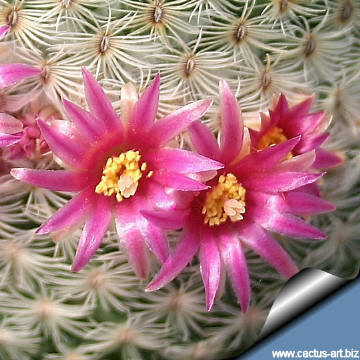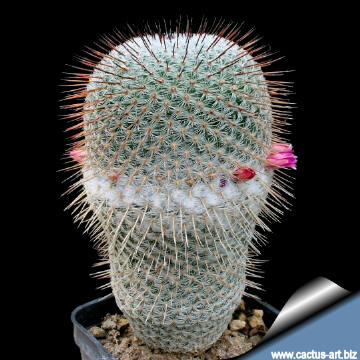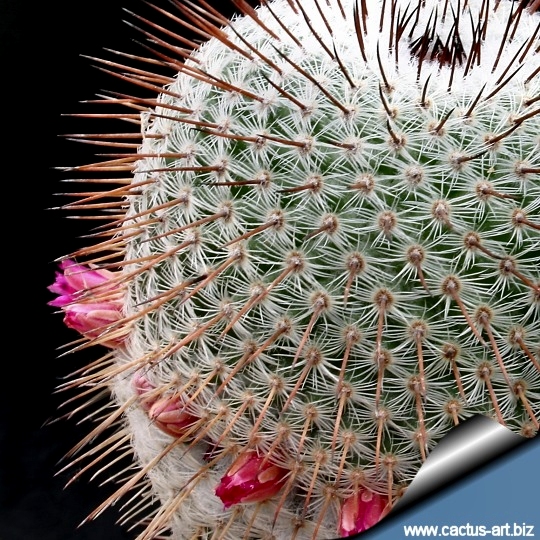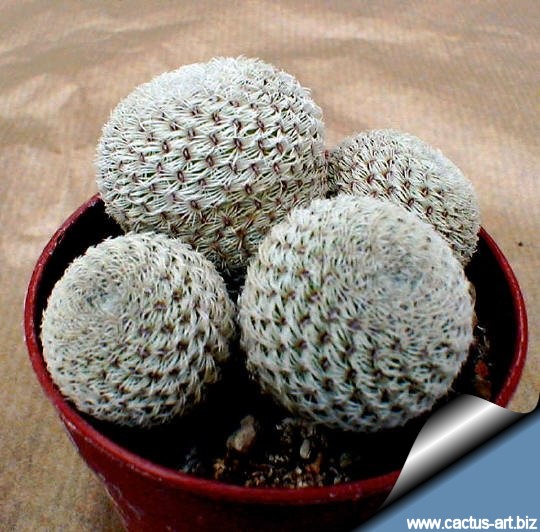|
|
|

Mammillaria tlalocii is an attractive and rewarding cactus with
dense white spines
The slow growth rate make
it one of the most sought-after species.
|
|
Description: Globular
cactus, solitary or clumping dichotomously; usually this species don't
produces lateral shoots. But in cultivation are frequently seen plant that
branch profusely from the base.
Stem: Globose, later columnar, curving pipe-shaped, to 20 cm
long, 5 to 7 cm wide.
Axil: White-wooled.
Radial spine: 16 to 22, glassy white, 1 to 2 mm long, the longer
sideways pointing.
Central spine: On the areoles at the apex of the plant, with age,
may appear a single longer brown-black central spine 6-10 mm long.
Flower: Carmine-pink, 12 to 14 mm long, 8 to 10 mm wide.
Flowering time: Blooms in late winter, early spring.
Fruit: Carmine-pink small.
Seed: Small, brown. |

A very showy species with minute
white spines and purple flowers.
|

Forms rings of small carmine-pink flowers in spring. |
|
Cultivation: It is a slow
growing species .
Use pot with good drainage and a very porous
mineral-based potting mix, keep dry in
winter. Pot plants are quite
wet-sensitively. Care must be taken with watering (Rot prone)
and needs good
drainage. Water sparingly
during the
growing season, keep very dry in
winter. Feed
with a high potassium fertilizer in summer.
Usually it is recommended to
overwinter this plant in a bright and warm greenhouse with at least
8-10° C , but it proved to be quite
frost resistant
(if kept dry it hardy as low as -5° C)Outside
full sun or afternoon shade, inside needs bright light, and some direct
sun.
Some plants will offset readily, and clumps can be produced in a very
few years.
Propagation: Direct sow after
last frost,
cuttings or
grafting.
|
|

An old specimen
|

|
|
Photo of conspecific taxa, varieties,
forms and cultivars of
Mammillaria
crucigera
complex
(This
Taxon has lots of synonyms whit
several controversial varieties and subspecies):
|
|
Advertising
|
|
|
|
|
Family:
Cactaceae (Cactus
Family)
Scientific name: Mammillaria
tlalocii Reppenhagen 1989
Published in: Gattung Mammillaria 1988: 120 (1989)
First description: by Reppenhagen, Gatt. Mamm. 120 (1987)
Origin: Mexico, (at the border of the states of Puebla and
Oaxaca).
Habitat: Altitude 800 to 1.000 m.
Conservation status: Listed in
CITES appendix 2.
Synonyms:
- Mammillaria crucigera subsp. tlalocii
(Reppenhagen) D. R. Hunt 1997
- Mammillaria buchenaui Backeberg
1963
- Mammillaria crucigera var. tlalocii
(Reppenhagen) Linzen et al. 1998
- Mammillaria crucigera var. grandinosa
Linzen et al. 1998
- Mammillaria crucigera Martius
1832
 |
|
|
|

Thin brownish-black centrals
will eventually form with age

This is one of the Mammillaria commonly called
"Owl Eye Cactus", known for
dichotomous branching (forking or dividing into two parts). Although
dichotomous branching is not a common occurrence in cacti in general, it
happens for some reason in this particular subspecies. What
is interesting about this cactus is that it began as a single head, and
it has now divided twice, forming what will be four separate branches.
When the division process started, it was obvious that four heads would
appear, but I don’t think the one head divided quadruply. Most probably,
one head became two, and then those two immediately divided.
Other Owl Eye Cactus among others comprise:
M. karwnskiana,
M. formosa,
M. microthele and
M. perbella.
|
|